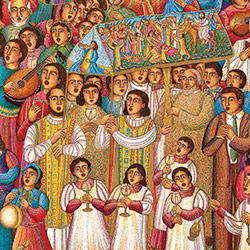The Bible & Theology Toward Christian Maturity
A Song of Witness
An Introduction to the Gospel of John
By Laura Sweat, Assistant Professor of New Testament and Winter Quarter Lectio Writer | Procession © 2014 John August Swanson / Eyekons
 John August Swanson, "The Procession" (detail). Hand-printed serigraph on paper, 36" × 24", 2007.
John August Swanson, "The Procession" (detail). Hand-printed serigraph on paper, 36" × 24", 2007.![]() Enlarge
Enlarge
Music is a powerful source of identity and connection. Even people with forms of memory loss often remember songs that they were taught at younger ages. Conversations about music — whether different kinds, particular songs, or individual artists — can produce intense memories, thoughts, and feelings. And the lyrics we sing often have the ability to change our thoughts and actions.
The early church certainly knew about the power of music. For example, Colossians 3:16 encourages believers to “sing psalms, hymns, and spiritual songs to God.” They also composed new pieces directly related to Jesus’ death and resurrection. While we no longer have the tunes available to us, we still have the lyrics. John 1:1–18 seems to have been one of these hymns.
Like the lyrics of a song, the first 18 verses of John 1, called the prologue, are easy to skim over without realizing what we are reading. However, the prologue introduces all of the major themes of John’s gospel: Jesus brings new life, Jesus reveals God and humanity, and Jesus provokes responses.
John 1:1 begins with a fairly obvious allusion to Genesis 1:1. In fact, one of the primary points of the Gospel of John is that Jesus reveals a God who brings life out of death. Just as God brought light out of darkness and ordered life out of chaos in Genesis, so also in John’s gospel Jesus is the light who shines in the darkness and the life that conquers death.
John succinctly says that Jesus reveals both God and humanity in one of the most profound verses of the prologue: “And the Word became flesh and made his dwelling among us, and we saw his glory, the glory as a unique one of the Father, full of grace and truth.” (1:14, author’s translation). While at times it may seem that Jesus is, in the words of scholar Ernst Käsemann, “God striding across the earth” in John, it is essential to look for the ways in which he is demonstrably “flesh,” too. It is the joining of the two, God and flesh, that is the gospel’s central focus.
John also makes another claim about the Word: He “made his dwelling (esken̄osen) among us.” This is an allusion to the way that God met the people of Israel in the Old Testament in the tabernacle (Exodus 35–40), known as a skene, or dwelling. As the Word made flesh, Jesus tabernacles among us, mediating God’s presence in our midst.
When the Word becomes flesh, he provokes both positive and negative responses. John the Baptist is the prologue’s example of a positive response. He offers testimony to Jesus, pointing away from himself and toward Jesus (who in turn often points away from himself and toward his Father; 1:15; 5:19–30).
Furthermore, John the Baptist sees clearly who Jesus is; he has beheld Jesus’ glory, just as “we” have (1:14). Testifying to Jesus and seeing him rightly are two of the best ways to respond to Jesus in this gospel. May we experience “grace upon grace” (1:16) as we seek to know the God revealed in and through Jesus in John’s gospel.
